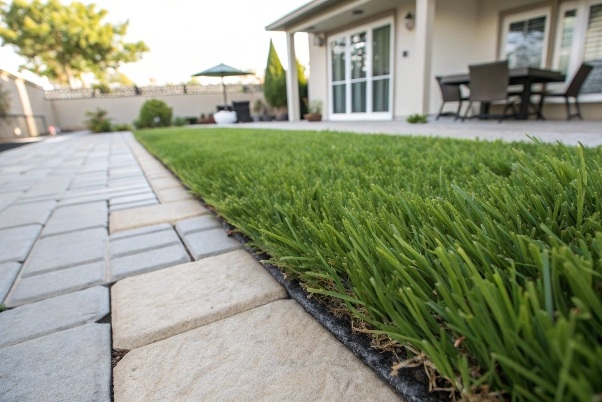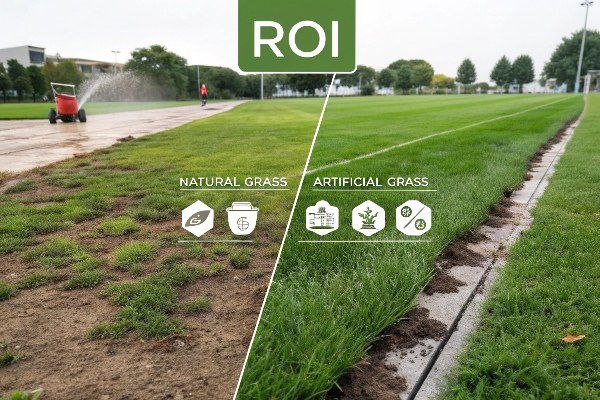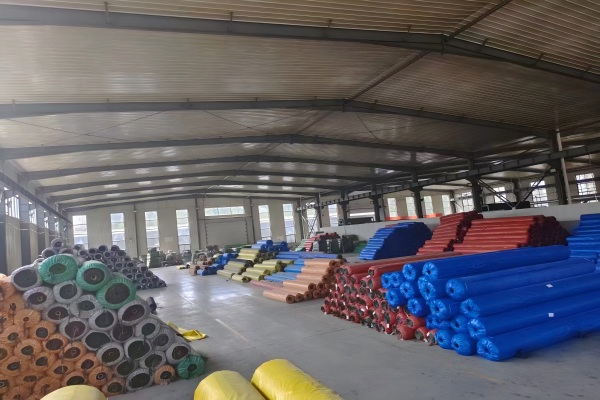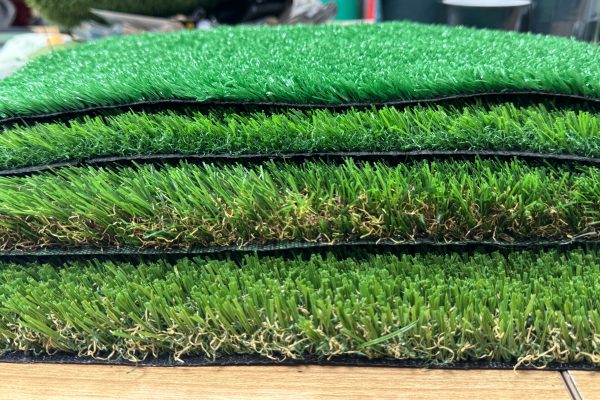Tired of costly outdoor flooring that requires constant upkeep? Finding a durable, budget-friendly solution can seem impossible, leaving your project’s profitability at risk.
Artificial grass is often the most cost-effective outdoor flooring over its lifespan. It combines a reasonable initial investment with nearly zero maintenance costs for water, mowing, and fertilizers, offering significant long-term savings for businesses compared to natural grass or hardscaping.

I have spent years in the artificial turf industry, helping business owners find the best value for their projects. Many people only look at the upfront price, but the real cost of outdoor flooring becomes clear over time. Let’s look closely at why artificial grass often wins on cost and how you can maximize your return on investment. The numbers and facts that I will share might surprise you and change the way you look at your next project’s budget.
How Does Artificial Grass Offer a Better ROI Than Other Outdoor Options?
Are high maintenance costs1 eating into your profits? Natural grass and paving require endless spending on water, labor, and repairs, making long-term budgeting a complete nightmare.
Artificial grass delivers a better return on investment (ROI)2 by stopping recurring expenses. Unlike natural grass, it needs no watering, mowing, or chemicals. Compared to hardscaping, it avoids costly repairs for cracks and weeds, making its total cost of ownership3 much lower over time.

When I talk with my clients, the conversation always turns to long-term value. A smart business owner knows that the initial purchase price is only one part of the equation. We must look at the total cost of ownership. I remember working with a business that managed several community sports fields4. They were spending a fortune on maintaining natural grass. We did a cost analysis5 over ten years, and the results were clear. Artificial grass required a higher initial investment, but the savings over the decade were huge. This is because the costs of watering, fertilizing, pesticides, and paying a grounds crew simply disappear. Let’s look at a simple breakdown.
Cost Comparison Over 10 Years (500 sq. meters)
| Flooring Type | Average Initial Cost | Estimated 10-Year Maintenance | Total 10-Year Cost |
|---|---|---|---|
| Artificial Grass | $7,500 – $15,000 | ~$500 (Cleaning) | $8,000 – $15,500 |
| Natural Grass | $1,000 – $2,500 | ~$20,000 (Water, Mowing, Etc.) | $21,000 – $22,500 |
| Paving/Pavers | $10,000 – $25,000 | ~$3,000 (Weeding, Repair) | $13,000 – $28,000 |
These numbers show a powerful story. But the ROI goes beyond just money saved on maintenance. Your space becomes more usable. After it rains, a natural grass field is a muddy mess. An artificial turf field is ready for play almost immediately. This means more booking time for sports facilities, which translates directly to more revenue. For a business, that is a critical advantage.
Why is Buying Wholesale Key to Making Artificial Grass Cost-Effective?
Paying retail prices for large projects can destroy your budget. You need a better way to source materials without lowering quality, but finding a reliable wholesale partner is tough.
Buying wholesale directly from a manufacturer like us at QH Grass dramatically lowers your per-unit cost. This allows you to get high-quality turf for much less than retail, maximizing your profit margins on installation projects and giving you a competitive edge when bidding.

This is the secret that separates successful businesses from struggling ones. When you buy from a local store, you are paying for every middleman along the way. I started my career in the factory workshop, so I have seen the entire supply chain from the inside. The product goes from the manufacturer to an exporter, then an importer in your country, then a distributor, and finally to the retailer. Each one of them adds their own profit margin. By the time you buy it, the price can be double or even triple the original factory cost. Buying directly cuts out all those extra layers.
The Advantage of Direct Sourcing
Working directly with a manufacturer is about more than just a lower price. It’s about control and partnership. You are not just a customer; you are a partner in the process.
| Factor | Buying From a Retailer | Buying Wholesale Direct |
|---|---|---|
| Price | High, includes multiple markups | Low, direct from the factory |
| Quality Control | You trust the retailer’s choice | You can set your own quality standards |
| Customization | Limited to available stock | Full control over specs, colors, etc. |
| Communication | Slow, through many layers | Direct contact with engineers and sales |
| Support | Basic product knowledge | Expert technical support and advice |
For a business owner who is bidding on large projects, these advantages are critical. When you work directly with me and my team at QH Grass, you can get exactly the turf you need for a specific project. We can adjust the pile height, density, and backing to meet your performance and budget requirements. This level of control is impossible when you buy off the shelf from a retailer. It gives you the power to win more bids and increase your profits.
What Factors Determine the True Cost of Artificial Turf for a Business?
Are you confused by the wide range of turf prices you see? Choosing the wrong specifications can lead to a product that fails early or costs too much, hurting your reputation and your bottom line.
The true cost is determined by more than the price tag. Key factors include pile height, density, yarn material, and backing. A higher-spec turf costs more upfront but offers better durability and longevity, resulting in a lower lifetime cost for commercial applications.

I always tell my clients to think of buying turf like buying a professional tool. A cheap hammer might work for a few nails, but it will fail on a big job. You have to match the tool to the task. The same is true for artificial grass. The specifications of the turf directly impact its performance, lifespan, and, ultimately, its true cost. A cheap product that wears out in three years is far more expensive than a quality product that lasts for ten years or more. Understanding the key specifications is essential for making a smart investment. I help my clients navigate these details every day.
Key Turf Specifications That Affect Cost and Performance
Let’s break down the most important technical details. Knowing this information allows you to have an intelligent conversation with any supplier and ensure you get what you pay for.
| Specification | What It Means | Impact on Cost & Durability |
|---|---|---|
| Pile Height | The length of the grass blades in mm. | Longer blades often feel softer but can be less resilient. Cost increases with height. |
| Density (Stitch Rate) | How many stitches are in a square meter. | Higher density means more yarn, which makes the turf plusher, more durable, and more expensive. |
| Dtex | The weight of the yarn in grams per 10,000 meters. | A higher Dtex means a thicker, stronger yarn. This is critical for high-traffic areas and increases cost. |
| Backing | The material that holds the turf together. | A double-layer backing with a PU (Polyurethane) coating is more durable and weather-resistant than a single-layer Latex backing. PU is more expensive but a better long-term investment. |
For a business that installs sports fields, I always recommend focusing on high Dtex and a strong PU backing. The field needs to withstand heavy use. For a decorative landscaping project, we might focus more on a specific pile height and color for better aesthetics. It is all about finding that perfect balance between performance, appearance, and your budget.
Conclusion
In summary, artificial grass is a top cost-effective choice for outdoor flooring. Buying wholesale and choosing the right product specifications are crucial for maximizing your return and ensuring project success.
-
Learn about the significant savings on maintenance costs when choosing artificial grass over natural options. ↩
-
Understanding ROI helps you see the long-term savings and benefits of switching to artificial grass. ↩
-
Explore how total cost of ownership can impact your budgeting and decision-making for outdoor options. ↩
-
Discover how artificial grass enhances the usability and revenue potential of community sports fields. ↩
-
A detailed cost analysis reveals the financial advantages of artificial grass in the long run. ↩
_画板-1.png)
_画板-1.png)